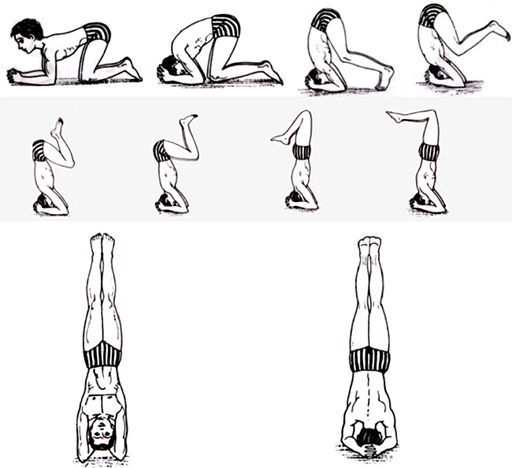Sirshasana (Headstand Pose)

Description
Sirshasana, also known as the Headstand Pose, is an advanced yoga posture that involves balancing the body on the head and forearms. This pose offers various physical and mental benefits.
Execution
Stage 1:
- Begin in Vajrasana (thunderbolt pose).
- Close your eyes and relax your body.
- After a few minutes, open your eyes and bend forward.
- Place forearms on a folded blanket, fingers interlocked.
- Elbows form an equilateral triangle with interlocked fingers.
- Place the crown of the head on the blanket between your hands.
- Wrap hands around the head for support against rolling.
Stage 2:
- Lift knees and buttocks off the floor, straightening legs.
- **Stage 3:** Walk feet closer to head, lower chest.
- Press body weight onto head and arms for balance.
- Raise one foot about 20 cm, then the other and balance.
Stage 4:
- Gradually raise lower legs, knees bending.
- Fold legs toward buttocks, contracting lower back muscles.
- Maintain balance, knees pointing down, legs together.
Stage 5:
- Raise knees vertically, straighten hips and thighs.
- Balance body.
Stage 6:
- Straighten your knees, and raise your lower legs.
- Body in a straight line, feet relaxed.
Stage 7:
- Close your eyes, balance, and relax in the final position.
- Return to starting position, lowering the body in reverse.
Breathing
- Inhale while raising the body.
- Breathe normally in the final pose.
- Breath becomes subtler as practice progresses.
Duration
- Beginners: Start with 10 to 30 seconds, add seconds weekly.
- Adepts: 3 to 5 minutes for general health.
- Advanced practitioners: Up to 30 minutes.
Awareness
- Physical: Balance and body adjustments.
- For adepts: Brain, center of the head, or respiration.
- Spiritual: Focus on Sahasrara Chakra (crown chakra).
Sequence
- Beginners: End of the asana program.
- Experienced practitioners: Beginning or end.
- Follow with Tadasana (Mountain Pose), then Shavasana (Corpse Pose).
Contraindications
- Avoid neck issues, headaches, high blood pressure, heart disease, etc.
- Not during pregnancy or menstruation.
Benefits
- Awakens Sahasrara Chakra.
- Revitalizes body and mind, relieve anxiety.
- Addresses psychological disturbances.
- Aids nervous and glandular disorders.
- Reverses gravity’s effects, and aids tissue regeneration.
- Improves diaphragmatic function.
- Reverses blood flow, aids tissue rejuvenation
Practice Note
- Most weight on the head, arms for balance.
- Beginners can use arms for support.
- If falling, relax and try to minimize impact.
